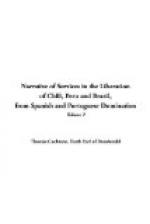An incident occurred during the contest which, at this distance of time, I shall not refrain from mentioning. His Britannic Majesty’s ship Hyperion was so close to the Esmeralda, as to be a witness of the whole proceeding. A midshipman was standing at the gangway looking on, amongst others, when his truly English nature, unable to restrain itself as our gallant fellows cleared the forecastle of the enemy, gave vent to its expression by clapping his hands in approbation. It was afterwards reported that he was immediately ordered below by his commander, Captain Searle, who threatened to put him under arrest. Such was the feeling of an English commander towards me. I should not have condescended to notice this occurrence but for the bravado shown by the same officer on a previous occasion, by casting loose his guns, with their tompions out, when my flag-ship entered the roads; thereby either intimating that he considered me a pirate, or that he would so treat me, if he had an opportunity.
When approaching the Esmeralda, the British frigate also hailed each boat separately, with the evident intention of alarming the enemy; which would no doubt have been the case, had not the Spaniards been thrown off their guard by the before-mentioned ruse of sending the ships out of the bay.
Far different was the conduct of the commander of the United States frigate Macedonian—whose sentinels did not hail the boats—the officers in an under-tone wishing us success; and still more honourable was the subsequent testimony of that talented officer, Captain Basil Hall, who commanded His Britannic Majesty’s ship Conway, then in the Pacific. This testimony, though in some degree a recapitulation of the events already related, but slightly inaccurate as regards the number of men employed, I feel proud to adduce:—
“While the liberating army, under General San Martin, was removing to Ancon, Lord Cochrane, with part of his squadron, anchored in the outer roads of Callao. The inner harbour was guarded by an extensive system of batteries, admirably constructed, and bearing the general name of the ‘Castles of Callao.’ The merchant ships, as well as the men of war, consisting of the Esmeralda, a large 40-gun frigate, and two sloops of war, were moored under the guns of the castle, within a semicircle of fourteen gun-boats, and a boom made of spars chained together.”
“Lord Cochrane, having previously reconnoitred these formidable defences in person, undertook, on the 5th of November, 1820, the desperate enterprise of cutting out the Spanish frigate, although she was known to be fully prepared for an attack. His Lordship proceeded in fourteen boats, containing 240 men—all volunteers from the different ships of the squadron—in two divisions, one under the orders of Captain Crosby, and the other under Captain Guise, both officers commanding the Chileno squadron.”




